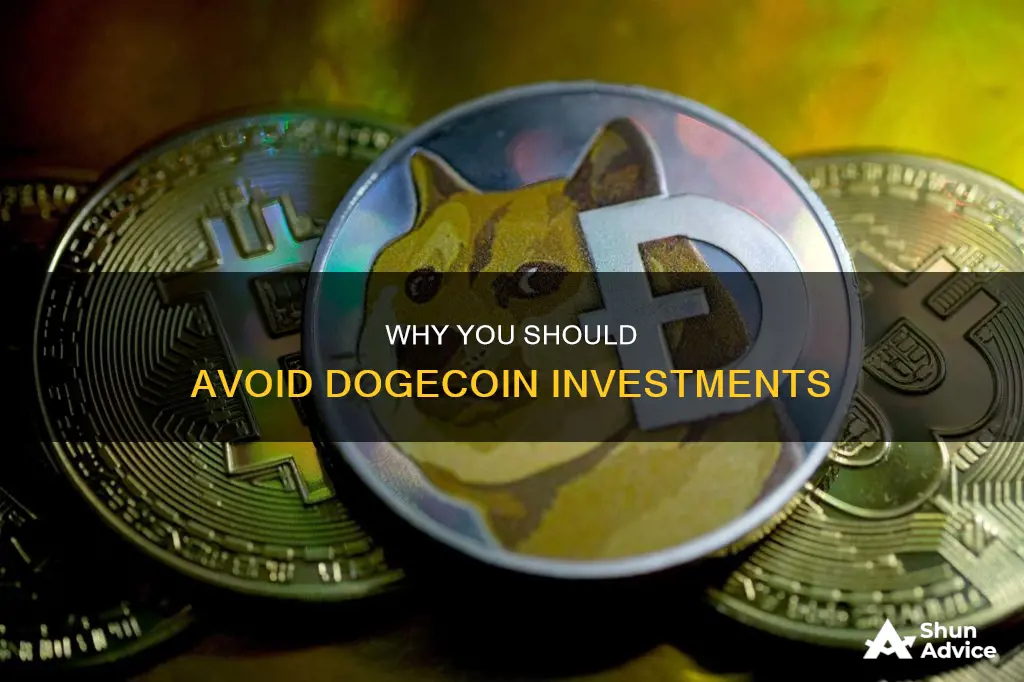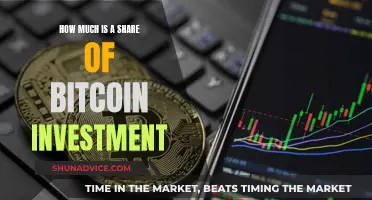
Dogecoin is a cryptocurrency that was launched in 2013 as a joke based on a popular meme character -- a Shiba Inu dog. It has gained a lot of attention recently, with its value increasing by more than 10,000% since the beginning of 2021. However, despite its popularity, there are several reasons why investing in Dogecoin may not be a good idea. Firstly, Dogecoin has extremely limited utility, with very few businesses accepting it as a form of payment. Secondly, it lacks differentiation from other cryptocurrencies and has no real-world catalysts driving its value. Additionally, Dogecoin has an infinite supply, which can dilute the value of existing coins. Finally, Dogecoin is highly volatile and risky, making it unsuitable for long-term investors. Therefore, while Dogecoin may be a lucrative short-term investment, it is important to proceed with caution and only invest what you are willing to lose.
| Characteristics | Values |
|---|---|
| Volatility | Dogecoin is highly volatile, making it a risky investment |
| Lack of credibility | Dogecoin was created as a joke based on a meme |
| Limited utility | There is little real-world use for Dogecoin |
| Lack of differentiation | Dogecoin has no unique features or purpose |
| No fundamental catalysts | Dogecoin's value is driven by social media hype rather than tangible drivers |
| Infinite supply | Unlike other cryptocurrencies, Dogecoin has no supply cap |
| Short-term investment | Dogecoin is better suited for short-term traders than long-term investors |
What You'll Learn

Dogecoin has no real-world use
Dogecoin has been described as a "meme coin" and a "joke" cryptocurrency. It was created in 2013 by software engineers Billy Markus and Jackson Palmer, who wanted to satirize the hype surrounding cryptocurrencies at the time. Dogecoin has no supply cap, and its value is highly volatile.
Dogecoin's value is highly dependent on media attention and celebrity endorsements. For example, in 2020, a TikTok trend aimed at getting Dogecoin to $1 caused its price to spike. Similarly, Tesla and SpaceX CEO Elon Musk has frequently tweeted about Dogecoin, causing its price to rise. However, Dogecoin's value is also susceptible to sharp crashes, and it has been described as a risky investment.
Dogecoin's creators, Markus and Palmer, distanced themselves from the cryptocurrency in 2015, citing a toxic environment and their belief that cryptocurrency is fundamentally exploitative. Palmer has also expressed concern about the forces driving Dogecoin's success, arguing that it shows traders aren't doing their due diligence.
Strategic Bitcoin Investments: How Much to Invest?
You may want to see also

Dogecoin has no supply cap
There are a few reasons why Dogecoin was created without a supply cap. Firstly, the developers wanted to create a currency that people would be more likely to spend rather than hold onto as a store of value. By making Dogecoin inflationary, they hoped to encourage transactions and everyday use. Additionally, Dogecoin was designed to have low transaction fees, large block rewards, and other benefits that arise from not having a supply cap.
The absence of a supply cap has implications for the long-term value of Dogecoin. Without a cap, the price of Dogecoin may struggle to rise significantly above its peak of $0.70 in May 2021. Dogecoin also has less appeal for buy-and-hold investors who are seeking assets that will appreciate over time. However, the inflationary nature of Dogecoin may make it more attractive as a transactional currency.
Some have suggested that Dogecoin could implement a supply cap in the future, but this seems unlikely. The Dogecoin community tends to value the benefits that come with not having a cap, such as low transaction fees and large block rewards. Additionally, there has been little discussion about implementing a cap, and any change to the protocol of a cryptocurrency would require community consensus.
Bitcoin Halving: Pre- or Post-Event Investment Strategy?
You may want to see also

Dogecoin lacks differentiation
Dogecoin was created in 2013 by software engineers Billy Markus and Jackson Palmer, who were working at IBM and Adobe Systems, respectively. The idea was to poke fun at the explosion of cryptocurrencies and the way people were investing in things they didn't understand. Unfortunately, that is exactly what happened.
Dogecoin was created by combining two of the buzziest things on the internet at the time: cryptocurrencies and the Doge meme, which features a Shiba Inu dog. Markus and Palmer coded the digital currency in about three hours.
Dogecoin is often described as a "meme coin" and a "joke" cryptocurrency. It was not intended to be taken seriously and was not designed to be a long-term investment or effective store of value. In fact, Dogecoin has no supply cap, and millions of new coins are released onto the market daily, making it a highly inflationary cryptocurrency. This puts downward pressure on its value and makes it less attractive for long-term investment.
Dogecoin's lack of differentiation means that it is no different from dozens of other tradable cryptocurrencies. It has been described as having "no real-world use" and "no intrinsic value." Its ascent has largely been driven by social media hype and celebrity endorsements, rather than any fundamental catalysts or tangible drivers.
Dogecoin also suffers from potential lack of decentralisation and security risks due to the concentration of Dogecoins in a small number of wallets. This gives a few large holders undue control over price fluctuations and liquidity in the market, and introduces additional risks associated with certain actors being able to change Dogecoin at will and to their benefit.
A Guide to Investing in Litecoin: Getting Started
You may want to see also

Dogecoin lacks fundamental catalysts
Dogecoin is a cryptocurrency that was launched in 2013 as a joke based on a popular meme character—a Shiba Inu dog that speaks in broken English. It has since become one of the most talked-about and controversial cryptocurrencies.
However, Dogecoin is facing several challenges that could hinder its growth and long-term value. Firstly, Dogecoin has an infinite supply of coins, which is in contrast to Bitcoin and other cryptocurrencies that limit supply to avoid inflation. This lack of supply cap and the presence of over 100 billion Dogecoins in circulation could impact its value in the long term.
Dogecoin also faces the challenge of attracting new participants to its network. According to on-chain data, the number of new Dogecoin addresses has been gradually decreasing, indicating a lack of new users joining the network. Additionally, the number of transactions has been mixed, with only a few short-lived spikes in activity. The network is also predominantly active in Western time zones, suggesting that the APAC region could present a potential growth opportunity.
Another concern is Dogecoin's lack of utility. Unlike other cryptocurrencies, Dogecoin is not taking significant steps to transform its blockchain or increase its utility. For example, there are no immediate plans to make the Dogecoin blockchain smart contract-compatible, limiting its ability to get involved in areas such as non-fungible tokens (NFTs) and decentralized finance (DeFi). This could be a significant drawback as these areas are some of the most promising in the crypto world.
Dogecoin's value is also highly volatile. It has experienced significant price fluctuations, including a peak in May 2021 due to support from celebrities like Elon Musk and a subsequent decline, with a low price in 2023. This volatility makes it a risky investment, especially for long-term investors.
While Dogecoin has gained popularity and attention, it lacks the fundamental catalysts necessary to drive sustainable growth and long-term value. It is essential for investors to carefully consider these factors before investing in Dogecoin or any other cryptocurrency.
International Students: Bitcoin Investment Opportunities and Risks
You may want to see also

Dogecoin is a risky investment
Dogecoin is a "meme" cryptocurrency that was launched in 2013 as a joke based on a popular meme character, a Shiba Inu dog. It is a highly volatile cryptocurrency, and its value is too easily manipulated. Dogecoin's price history has been volatile, and it has lost as much as 93% of its value from its all-time high.
Dogecoin has no cap on its supply, meaning its supply is inflationary over time, and this is in contrast to Bitcoin's hard cap of 21 million coins. This lack of scarcity will likely keep Dogecoin's price suppressed. Dogecoin is also yet to find a real-world use case, and its value is driven by hype and speculation.
Dogecoin is susceptible to social media hype and the influence of celebrity endorsements, which can cause its price to soar or plummet. For example, billionaire Elon Musk has tweeted about Dogecoin several times, causing its value to increase drastically. However, this is not the same as adoption, which is the most critical measure of success for any cryptocurrency.
Best Altcoins to Invest in Now
You may want to see also
Frequently asked questions
Dogecoin is a risky investment because it is extremely volatile. Its price can fluctuate dramatically in a short period, and it doesn't have the credibility of other cryptocurrencies like Bitcoin.
Dogecoin has the potential for short-term gains and is a fun investment vehicle. It also has a low cost of entry, making it accessible to many investors.
Dogecoin has a high risk of loss and a lack of decentralization. It also has extremely limited utility, with few businesses accepting it as a form of payment.
Instead of investing directly in Dogecoin, one can consider investing in crypto stocks, i.e., companies linked to the crypto market, such as Tesla, Shopify, and NVIDIA.
Dogecoin is a cryptocurrency that was launched in 2013 as a joke based on a popular meme character, the Shiba Inu dog. It was meant to poke fun at the explosion of cryptocurrencies and how people were investing in things they didn't understand.







